The ASUS Republic of Gamers G751 Review: G-SYNC Comes To The Notebook Computer
by Brett Howse on July 29, 2015 8:30 AM ESTSystem Performance
To start on the performance section, let’s take a look at how the ASUS G751 performs when running applications on the desktop. Powering the ASUS G751 model that was shipped for review is the Intel Core i7-4720HQ processor. At this point in the life of the fourth gen Core i7 processors, it may seem out of date, but the i7-4720HQ was actually just launched in Q1 2015. It is a quad-core, eight-thread processor with a base frequency of 2.6 GHz and turbo of 3.6 GHz. The maximum turbo is held in check by the 47 watt thermal design point, which is at the top end of the mobile processor range from Intel. It would have been nice to see ASUS move to Broadwell, but the quad-core mobile parts will likely be short lived anyway and have certainly been a long time coming.
With 24 GB of memory, the dual-channel memory is not balanced, with 8 GB on one channel and 16 GB on the other. ASUS does offer a model with a full 32 GB, or you can always order another stick of DDR3L-1600 if you want to change that. But as we will see in the scores below, performance is not impacted by this very much if at all, especially since the bandwidth-hungry iGPU is going unused.
Storage is a strong point on the ASUS G751, with ASUS being one of the first companies to start moving to PCIe based SSDs. The XP941 can achieve speeds over 1 GB/s, and while it has been surpassed by the Samsung SM951, it’s still a solid and quick PCIe SSD.
To take a look at general performance, the G751 was put through our laptop workloads. The graphs include other similar devices for comparison, but if you would like to compare the G751 against any other device we have tested, please check out our Notebook Bench.
PCMark
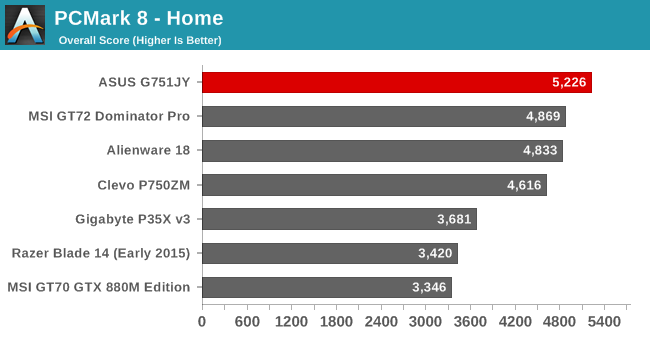
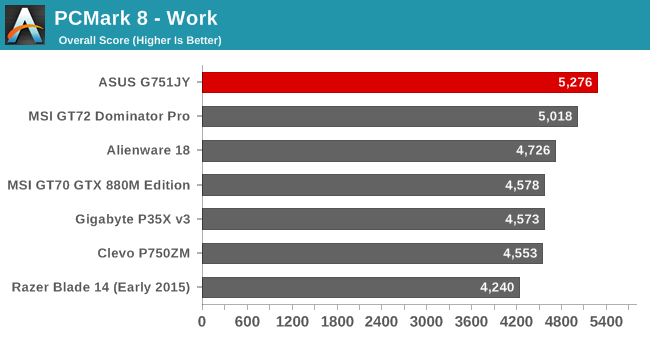

PCMark attempts to replicate real life workloads, and has several different tests which focus on specific workloads. The G751 performs very well in these tests, scoring the highest of any notebook we’ve tested. Since this is a comprehensive benchmark, the CPU is part of the equation, but so is the GPU, display resolution, and storage speed. ASUS has created a pretty well rounded notebook here.
Cinebench
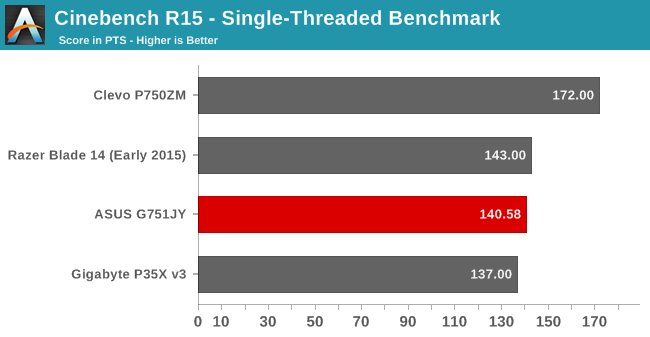
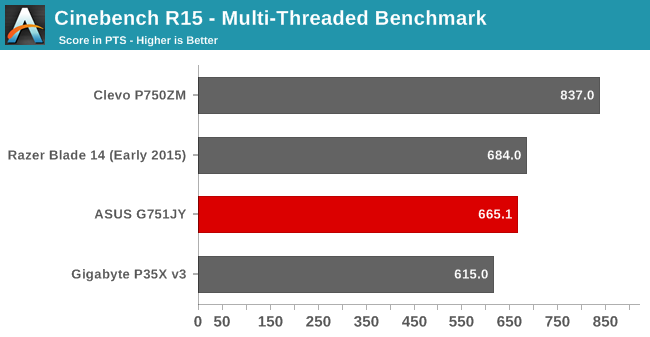
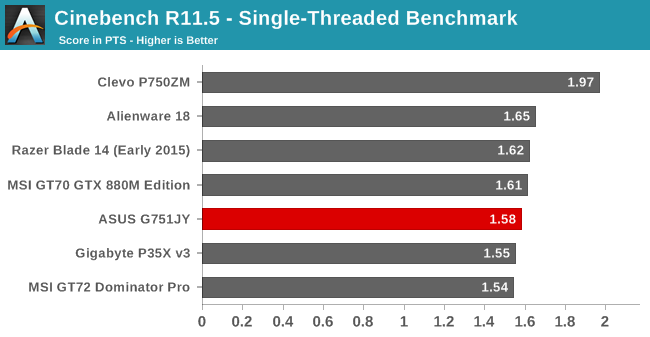
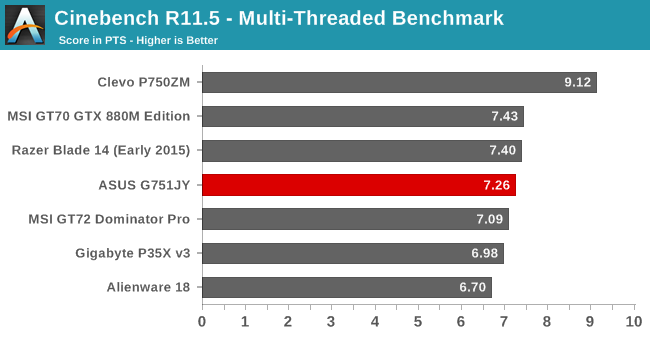
Cinebench tests the ability for the CPU to render an image, and it loves high frequencies and plenty of instructions per clock. The Core i7-4720HQ is fairly powerful in this test, and falls in line with scores similar to other notebooks that have a similar processor. The Clevo has a desktop class 88 watt processor, and runs away in this benchmark.
x264
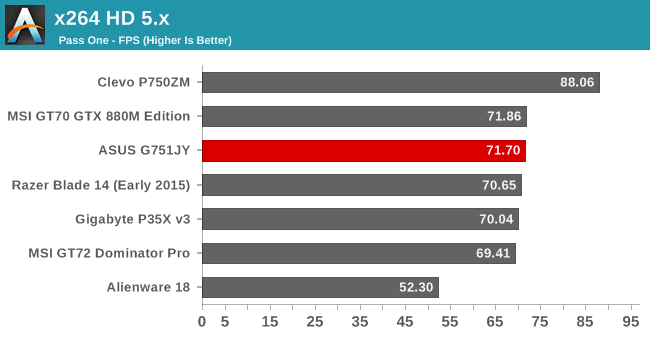
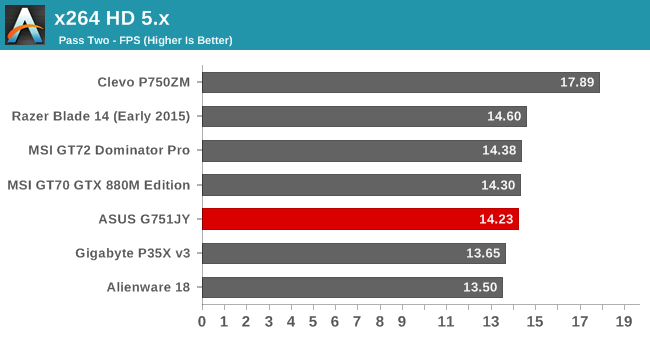
Much like Cinebench, the processor is the key to this score, and once again the i7-4720HQ performs right where you would expect it to, and the Clevo’s desktop processor once again reigns at the top.
Web Tests
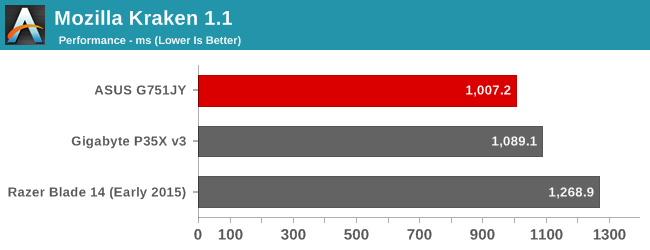
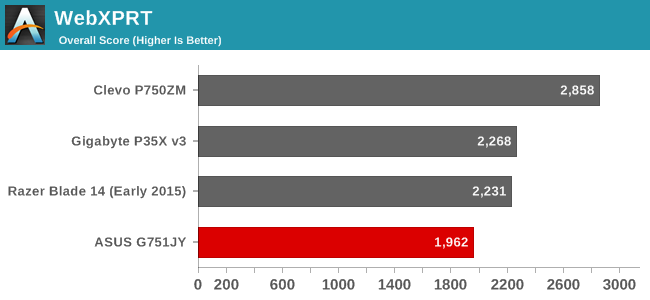
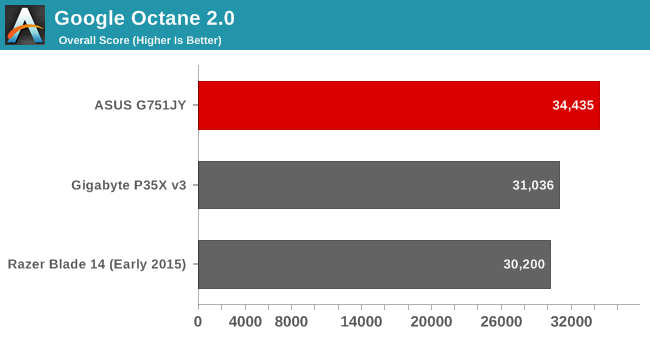
None of the laptops listed are going to struggle with web performance, but it is still handy to see where a fast quad-core system sits. The G751 performs well in the javascript benchmarks using Chrome as the browser. When Windows 10 ships, we can start to move over to Edge as the browser for our web tests.
Storage
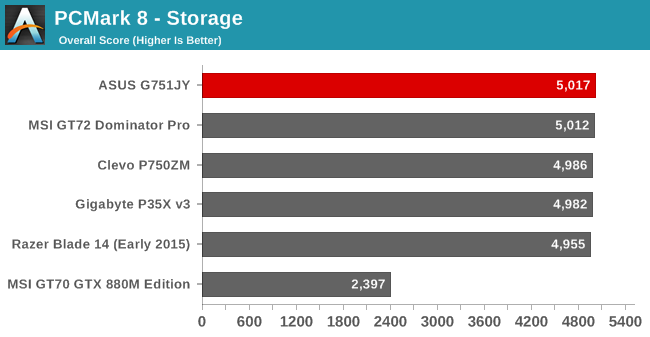
The PCMark Storage test runs traces on a couple of different workloads, but it tends to lump pretty much all SSDs fairly close together, so I’ve also added the CrystalMark Disk benchmark to give a quick glance at the speeds that the G751 can achieve with its PCIe based SSD. It’s been a while since we’ve tested a notebook with a disk based hard drive, so I thought it would be good to test the storage drive as well just so we don’t forget why we’ve moved to SSDs.



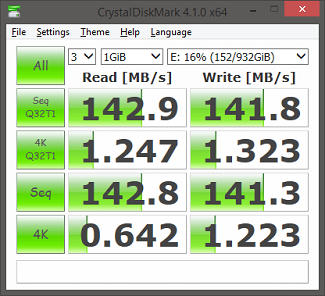








52 Comments
View All Comments
Meaker10 - Wednesday, July 29, 2015 - link
Indeed, the only way to get around this is to do what MSI have done and have a manual switch and on reboot move the traces over and run in IGP mode (without G-sync of course).Asus also only had the later G750 with optimus, before they actually avoided it generally in their 17 inch models. So really for asus the optimus models were a blip rather than a trend.
nerd1 - Friday, July 31, 2015 - link
Many laptops had hardware mux to switch GPU pre-optimus era (alienware had one) which is a way better solution than optimus.nightbringer57 - Wednesday, July 29, 2015 - link
As a matter of fact, everyone has been building some non optimus notebooks all the time.The Optimus technology requires the screen to be directly driven by the integrated GPU. Some custom technologies made by GPU manufacturers require the screen to be driven by the GPU himself. That's why the 3D laptops never sold, because Nvidia's 3D technology requires the screen to be driven by the nvidia GPU directly, so you can't have an Optimus-enabled 3D screen laptop (well, at least using nvidia 3D).
The same problem is true for G-Sync. So you can't technically have G-sync and optimus on the same laptop.
BMNify - Wednesday, July 29, 2015 - link
Exactly, the optimus tech even effects VR and you can't drive VR with igpu, many high end laptops are now coming without optimus due to customer demand.BMNify - Wednesday, July 29, 2015 - link
Optimus tech is reviled in the hardcore gaming community and gaming forums who pay $2000 plus for gaming laptops, many top-end gaming laptops have no optimus due to Customer demand !!Notmyusualid - Saturday, August 1, 2015 - link
^ This is true.Many don't buy a machine due to the very fact that Optimus is there.
However, I have a Dell M3800 HD4600/K1100M that has no issue with it.
boeush - Wednesday, July 29, 2015 - link
OK, bit why would anyone buy this now, when Skylake is right around the corner? Wait another couple of months, and an equivalent model with a better CPU and DDR4 is all but guaranteed by the holiday shopping season. Or, at the very least, this particular model will be selling at deep discounts by then...boeush - Wednesday, July 29, 2015 - link
Not to mention, a premium laptop this far into 2015, and with not a single USB 3.1 port? Tsk, tsk...meacupla - Wednesday, July 29, 2015 - link
because, you buy it when you need it, not when there is something new 'in a couple of months'.A week, sure, that's not a long wait, but 2 months to launch means you're going to be waiting another 6 months until the replacement for this type of gaming laptop to appear on the market.
boeush - Wednesday, July 29, 2015 - link
According to various leaks, Skylake H is launching in October. Skylake T (low voltage 35W i7 6700) is also launching about then or even sooner.Given that, why would anyone NOT expect all brands to refresh models with Skylake by Black Friday?? Any brand that fails to do that, is going to lose out huge this year.
So sure, retail availability of bixed CPUs is October, but I'll bet all the OEMs have had samples under NDA since spring, and are working to deliver updated models on the same day as the CPU launch.